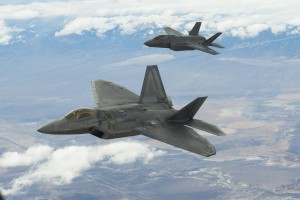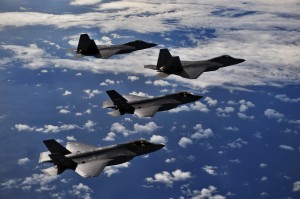2015/09/15 By Robbin Laird
During my recent visit to Australia, where the Royal Australian Air Force is shaping its path ahead with regard to transformation via what it calls Plan Jericho, its combat experience in the Middle East is providing an important input to the way ahead.
As the new Chief of Staff of the RAAF, Air Marshal Davies, put it:
Question: Your Super Hornets flew for the first time in combat with F-22s.
What was the experience and what did you learn from that?
Air Marshal Davies: We have flown in Red Flag with F-22s and that training was crucial to operations in the Middle East. The pilots came back and said “it was just like in Red Flag.”
For us, at the moment the F-22 is a surrogate for the F-35, although with regard to combat systems and roles, the F-35 will be superior to the F-22.
But the point is to get the operational experience.
And the head of the RAAF Air Combat Group added that his recent combat experience with the F-22 highlighted the transition to fifth generation-enabled concept of operations as a core contributor to the way ahead for the RAAF.
Air Commodore Steven P. Roberton, Commander of Air Combat Group (ACG) and Commander of the Australian Air Task Group 630 in the Middle East in September 2014 highlighted the impact of the F-22 on the RAAF and its operations as follows:
In broad terms they have the fifth generation sensor package which can help provide information you wouldn’t otherwise get from something standing off.
We’ve got great capabilities in Wedgetail, but sometimes you really need a penetrating capability that can use the full spectrum and pass on information closer to the target.
Operating the Super Hornet with the F-22 and then receiving their data allowed us to operate more effectively. Our training with the F-22s in exercises like Red Flag has been crucial not only to prepare ourselves for combat but also to rethink how we operate our own fighter fleet.
We have adapted a lot of our tactics and procedures to do that same sort of leverage that the F22 practices with the Eagle community but clearly at lower levels between our Super Hornet to Hornet. That becomes pretty important for us to get the most out of our classic Hornets.
In other words, we are adapting our concepts of operations anticipating the entry into service of the F-35 and the readjustment of the role of the Super Hornet. We are preparing ourselves thereby for the transition to the F-35 enabled force. The Super Hornets and Growlers are enhancing our current capabilities, and we can work through how the F-35 will redefine their roles in the evolving force. We know we’ve got a lot to learn.
One problem with how people interpret the F-35 is thinking fifth generation is only about stealth; it is about data fusion and the capability to make the other air combat assets more viable and effective. It is a significant force multiplier, rather than commentators who want to see it as some kind of silver bullet.
In other words, the RAAF is working a fifth generation warfare transition under the impact of their own experience with the F-22 as well as operating with the USAF in the Middle East in terms of its impact on operations in the Middle East.
Although interesting to discuss this transition in Australia, it made a great deal of sense to go to where the F-22s are based to generate the operations which the Aussies discussed.
During a visit to Langley AFB on September 2, 2015, I was able to discuss the USAF implementation of a fifth generation warfare approach and the impact of the F-22 and the coming of the F-35 upon the re-working of fleet ops seen in the Middle East and elsewhere.
Carlisle emphasized throughout our meeting the importance of the training transition throughout the fleet, not simply the operation of the F-22 and the coming of the F-35 as in and of themselves activities.
It is about force transformation, not simply the operation of the fifth generation aircraft themselves as cutting edge capabilities.

General Carlisle: “It is important to look at the impact of the F-22 operations on the total force. We do not wish, nor do the allies wish to send aircraft into a contested area, without the presence of the F-22.
It’s not just that the F-22s are so good, it’s that they make every other plane better. They change the dynamic with respect to what the other airplanes are able to do because of what they can do with regard to speed, range, and flexibility.
It’s their stealth quality. It’s their sensor fusion. It’s their deep penetration capability. It is the situational awareness they provide for the entire fleet which raises the level of the entire combat fleet to make everybody better.”
The shift is to a new way of operating.
What is crucial as well is training for the evolving fight, and not just remaining in the mindset or mental furniture of the past.
It is about what needs to be done NOW and training towards the evolving and future fight.
General Carlisle: “The F-22s are not silver bullets.
The F-22s make the Eagles better, and the A-10s better, and the F-16s better. They make the bombers better.
They provide information. They enable the entire fight.
And its information dominance, its sensor fusion capability, it’s a situational awareness that they can provide to the entire package which raises the level of our capabilities in the entire fight.
This is not about some distant future; it is about the current fight.”
He emphasized the need to shift from a fourth generation mentality where a large combat force is moved to enable any single platform, such as the A-10. It’s a change of mentality to fifth generation thought.
“It’s the way we train the airman and the crews. It’s the scenarios we put them through. It’s the Red Flags and the integration phase of weapon school.
What we teach right now is fifth generation con-ops. That includes the Raptors and what they bring to the fight, and the F-35s and what they bring to the fight, and what the cyber systems bring to the fight.
How do you bring space into that environment?
How does C2 operate inside of an information flow that is inside of anything the adversary can do?
How do you put the C2 at the point that it can execute at a rate and with information superiority that is far better greater than an adversary can react to?
And then it’s the way we train our airmen to think in fifth generation terms, rather than just flying a new platform.”
He also emphasized that in the current Middle Eastern operations, F-22s because of their multi-mission flexibilities, are pressed into duty across the spectrum of operations and perform a variety of missions for the force, ranging from C-2 to ISR to strike to air defense to other missions as well.
Question: When we visited Nellis earlier this year, we highlighted that one key advantage, which the USAF brings to the evolution of fifth generation, enabled warfare, is the ability to fly LO versus LO aircraft.
How important is that to shaping the way ahead?
General Carlisle: “We think it is very important.
We are shaping tactics and approaches for LO aircraft to fight LO aircraft, and to think in terms of LO enabled forces to fight against LO enabled combat forces.
The F-35 brings incredible EW and other capabilities into the fight and how do we operate those capabilities in a jamming and non-jamming environment for legacy systems or LO-enabled legacy systems?
How do we build a realistic threat to be able to do that?
We are working on it.”
Question: Training to leverage fifth generation capabilities is crucial to the modernization and training of the other elements of the air combat force so that those elements are adjusting their thinking and approaches as well.
How do you view this challenge?

General Carlisle: “With the need to use our training funds to prepare for the threats we are facing and will face, we need our airmen and crews to think forward not backwards towards yesterday’s concepts of operations.
Training for the concepts, which enabled the legacy aircraft, is simply not what we need to do going forward.
And with our young and innovative airmen, they are going out there and reinventing approaches to warfare.
Fourth generation system can operate much better and effectively when enabled by fifth generation SA and information, but that will not happen by itself, and requires rethinking how fourth generation systems will operate going forward.
We have young airmen who are flying F-15Es or F-16CJs and they’re going, hey, the Raptor can give me a particular capability.
The Lightning can provide an additional capability, which means I can do something, which I could not do before. It’s designed for this but I can make it do something different, and make it even better.
And that thought process really is a fifth generation dynamic of change, but does not happen if you do not put fifth generation in the driver’s seat driving that process of change.
It is not about improving the techniques of what we used to do; it is about rethinking fundamentally how we shape and execute information dominance in a fluid battlespace.”
Question: How important are key allies like Australia in shaping an innovative approach going forward?
General Carlisle: “The F-35 is a global aircraft and will provide significant opportunities for cross-cutting learning.
The RAAF is at the cutting edge of rethinking warfare, under the influence of fifth generation capabilities.
I think the RAAF because their size comes with a relative lack of bureaucracy and a more open approach are actually leaning further forward in some areas than we are.
But I think the joint aspect of the F-35 will be a powerful engine of change for the air services in the US as the Marines, the USAF and the USN work through lessons learned going forward from using their F-35s and reshaping on joint concepts of operations.
In this sense really the F-35 is a central part of our broader effort to transformation jointness.”
Editor’s Note: The term fourth and fifth integration may confuse things.
As the Air Commander Australia put with regard to the integration term:
Question: Too often integration means shooting for the lowest common denominator, and combat is not a place where the lowest common denominator is where you want to go.
Assimilation often passes for integration, but obviously you have in mind a much higher target for integration.
How would you characterize your target goal?
Air Vice Marshal Turnbull: Assimilation I think is a word that we don’t need to even have in our vocabulary because it’s implies vanilla and gray.
Lethal is the world we live in and people need to keep their eye on that fact.
We don’t play games and we’re here for a reason.
It is really about the shift to fifth generation warfare and the shift of legacy assets to work within a strategic shift to a new concept of operations.
It is also the case that fifth generation aircraft can do a variety of things as an integrated force that a fifth gen force working with legacy can not simply do.
Ed Timperlake’s work on the F-35 and tron warfare is one of the few pieces in the public domain that identifies a fifth generation way ahead.


